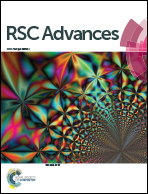Quick extracellular biosynthesis of low-cadmium ZnxCd1−xS quantum dots with full-visible-region tuneable high fluorescence and its application potential assessment in cell imaging
Abstract
The biosynthesis of metal nanoparticles/QDs has been universally recognized as environmentally sound and energy-saving, generating less pollution and having good biocompatibility, which is most needed in biological and medical fields. In the arena of chemical routes, however, biosynthesis has long been criticized for its low productivity, time-consuming process, and poor control over size, shape and crystallinity, keeping the much-needed technology away from practical application. In this work, a rapid and extracellular biosynthesis of multi-colour ternary ZnxCd1−xS QDs by a mixed sulfate-reducing bacteria (SRB)-derived supernatant was carried out for the first time to solve the problems plaguing this field of biosynthesis. The results showed that about 3.5 g L−1 of ZnxCd1−xS QDs with size of 3.50–4.64 nm were achieved within 30 minutes. The PL emission wavelength of ZnxCd1−xS QDs increased from 450 to 590 nm to yield multicolor QDs by altering the molar ratio of Cd2+ to Zn2+. The SRB-biogenic ZnxCd1−xS QDs have high stability in gastric acid and at high temperature, as well as excellent biocompatibility and biosafety, successfully entering growing HeLa cells and labelling them without detectable harm to cells. The SRB-secreted peculiar extracellular proteins (EPs) play a decisive function in the time-saving, high-yield biosynthesis of PL-tuned multicolor QDs, which cover an abnormally high concentration of acidic amino acids to provide tremendous negatively charged sites for the absorption of Cd2+/Zn2+ for rapid nucleation and biosynthesis. The strongly electrostatic connection between the QDs and the EPs and the increasing amount of EPs attached to the QDs in response to the increase of Cd2+ concentration account for their high stability and excellent biocompatibility.


 Please wait while we load your content...
Please wait while we load your content...